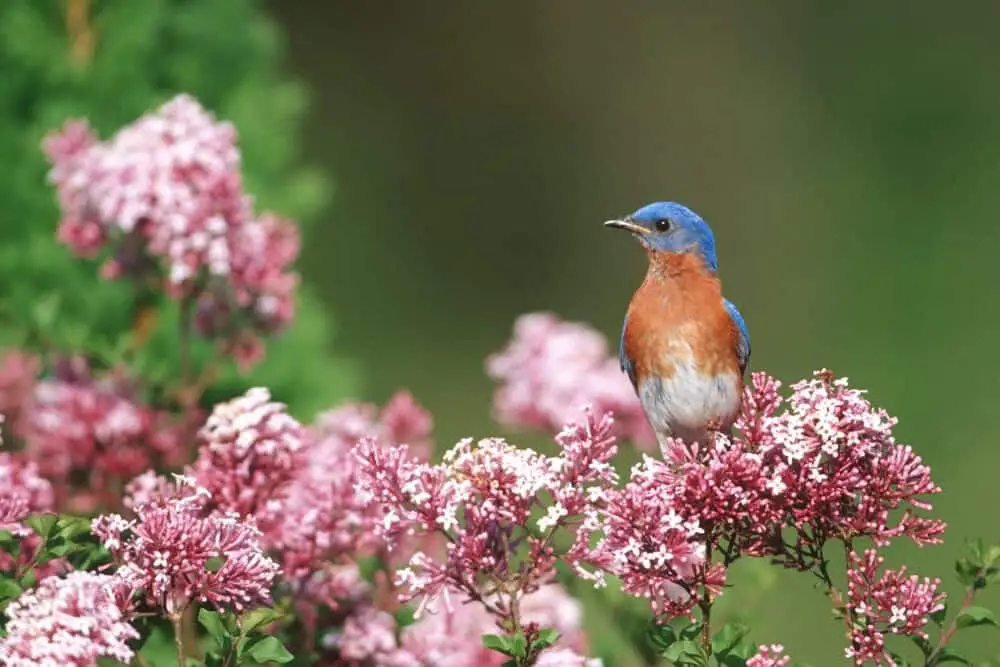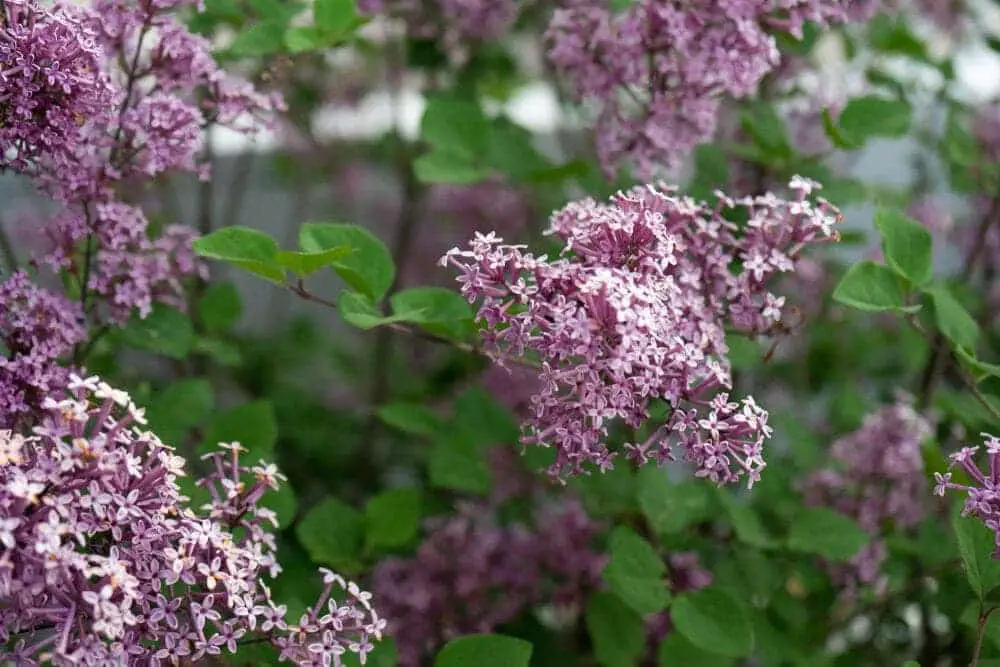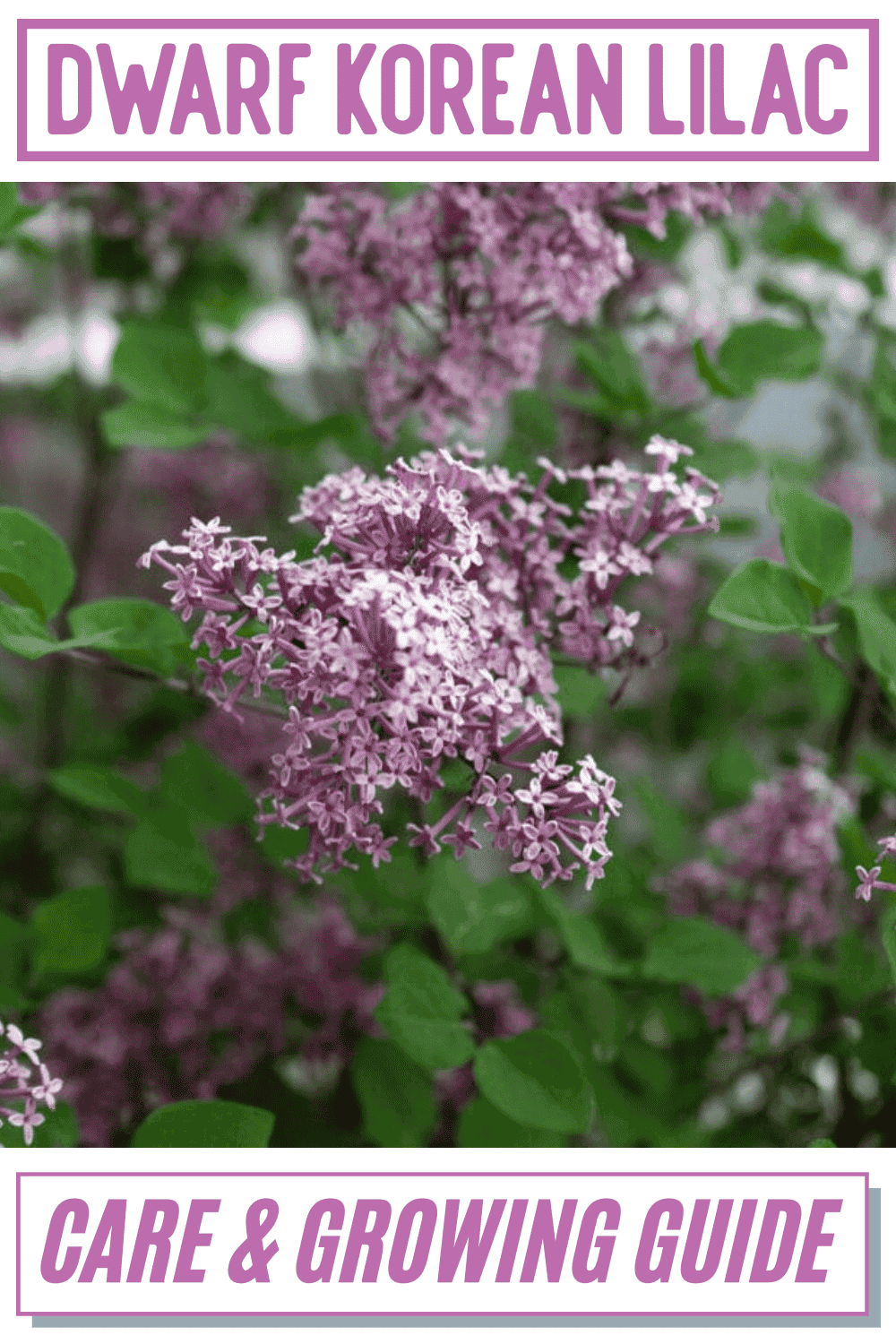The Dwarf Korean Lilac, also known as the Miss Kim Lilac, is a beautiful purple flower that must be cared for with the greenest of thumbs.
A delicate dance of moisture, basic soil, and pest control must come together to keep this lilac alive. This flowering bush is not for the impatient gardener.
Dwarf Korean Lilac Care & Growing Guide
1. Light requirements
The Dwarf Korean Lilac needs at least 6 hours of direct sunlight to stay healthy and strong. If it receives less than the 6 hours of light it requires, it will not have the energy to bloom. But if the sun is too intense, like in the summer during a heatwave, the flowers may wilt up and fall off.
2. Water
If you have young Korean lilac plants, you need to keep the soil moist. Do not let the lilac dry out until the roots have settled themselves into the soil, which takes at least six months or more. After that, you must water the lilac once a week in temperate weather, but if it gets hotter, then you have to water it every other day to every day.
3. Climate
Korean Lilacs do best in chilly northern climates, but not in snow or sleet. It can grow in places that have humidity or warm climates. But the more humid the weather is, the less it must be watered.
4. Soil
The soil that the Korean lilac roots into must be able to drain quickly, and it can’t have high acidity. The soil must be close to 7.0 basic soil, the closer to neutral, the better. If you can add humus to the soil, that would improve soil conditions even more.
5. Temperature
Cold temperatures are an everyday companion to the Korean lilac. It can survive in temperatures of around -30 degrees, but it won’t have any flowers on it.

7. Repotting
Korean Lilac bushes are not meant to be kept inside a home. They are outside plants since they take up so much room. But if you have a lilac bush you want to transfer over another area, then you must dig up a large area of soil.
The roots of the Korean Lilac travel across the soil and losing too many roots will cause transplant shock. Once you transfer the bush to the new hole, place compost on top of the area, but not underneath the bush or inside the soil.
For the first watering, soak the area thoroughly and continue to keep it damp for the next 3-4 weeks.
8. Speed of Growth
Lilacs are shrubs and faster growers, especially during the springtime. When the conditions are ideal, this flowering shrub can grow up to 8 inches in a year.
9. Height and spread
The Korea lilac can grow into a medium bush, with its height reaching four to five feet high and five to seven feet in diameter. It is not the largest bush in the lilac family, and it can also be trimmed and pruned slowly to decrease in size.
10. Flowers
The flowers of the Dwarf Korea lilac are the star of the show. They are incredibly fragrant and their purple and white coloring can beautify any garden or park. The flowers grow in clusters together and jot themselves out in front of the rest of the green foliage.
11. Trimming
The Korean lilac does not grow fast, so it isn’t necessary to trim it every year. But after it has reach full blooming during the spring and summer season, you should remove and withered and old foliage and flowers.

Is the Dwarf Korean Lilac plant poisonous?
No, the Korean lilac is not poisonous in any way to either humans or animals, so you can have it in your garden while you also have children and cats and dogs. But the lilac flowers are edible and fit for human consumption. Decorator used them in baking as edible flowers, however your lilacs may not taste that good, even though you can eat them. Edible flowers are specifically grown to taste good.
Can Dwarf Korean Lilac plants grow in water
No, Korean lilacs and most lilacs, in general, do not like to grow in too much water. If the ground is too moist, the flower will not bloom, and the roots might develop a rot.
How to get Dwarf Korean Lilac to flower?
The lilac flower bloom is a sight that you want to see during the spring and summer, so you should promote your lilac to bloom. Keep it watered but do not soak it and let it dry out a bit between watering. Make sure the soil stays close to basic, and when the bloom is done, prune the plant and get rid of dead and disease parts.
Common Plant Diseases of The Dwarf Korean Lilac
Because of the lilac’s large leaves, it can develop powdery mildew. It’s not a deadly plant fungus but it can make the leaves look ugly.
Once you see a white coloring, almost like a powder, on its leaves, you can wipe it off with a mix of baking soda and water or you can use a fungicide. Snails are very attracted to lilacs and they can destroy its stems and leaves because they are chowing down on them.
To keep snails away, you can spray a little bit of dish soap and water on the ground. Snails hate soap as it hurts their skin.
More like this:
Conclusion
- The Dwarf Korean Lilac can handle a range of temperatures and climates so that it can be planted in hardiness zones 3 to 9.
- This plant can survive in below-freezing temperatures.
- The amount of water you use on the lilac is the most important factor in its growth and bloom
- This bush tree is popular in South Korean as well as China.
- They are often used as tiny bonsai trees.
- Because the flower can be eaten, the flowers can be coated in candy and chocolate.
- Chefs can also make a lilac sugar.
- Using a fertilizer on this plant is a bad idea. The soil needs to be close to basic, so you should only use mulch and leave it on top of the soil.

Victoria is the owner and main author of hobby plants. She loves spending her free time in her garden planting and taking care of her plants. Victoria hopes you enjoy the content here!
![Queen Of The Night Flower [Complete Plant Care Guide] Queen Of The Night Flower [Complete Plant Care Guide]](https://www.hobbyplants.com/wp-content/uploads/2022/07/queen-of-the-night-flower-300x158.jpg)
![Mother Of Thousands Plant [Complete Plant Care Guide] Mother Of Thousands Plant [Complete Plant Care Guide]](https://www.hobbyplants.com/wp-content/uploads/2022/07/mother-of-thousands-plant-300x158.jpg)
![How Often Should You Water Pothos? [Complete Care Guide] How Often Should You Water Pothos? [Complete Care Guide]](https://www.hobbyplants.com/wp-content/uploads/2022/07/how-often-to-water-pothos-300x158.jpg)
![Can Snake Plants Live Outside? [COMPLETE CARE GUIDE] Can Snake Plants Live Outside? [COMPLETE CARE GUIDE]](https://www.hobbyplants.com/wp-content/uploads/2022/08/can-snake-plants-live-outside-300x158.jpg)
![Majesty Palm Plant Care: [Complete Beginner's Guide] Majesty Palm Plant Care: [Complete Beginner's Guide]](https://www.hobbyplants.com/wp-content/uploads/2022/08/majesty-palm-care-300x158.jpg)
![Exotic Angel Plant Care: [Complete Beginner's Guide] Exotic Angel Plant Care: [Complete Beginner's Guide]](https://www.hobbyplants.com/wp-content/uploads/2022/08/exotic-angel-plant-care-300x158.jpg)
![Do Coleus Like Sun Or Shade: [Complete Care Guide] Do Coleus Like Sun Or Shade: [Complete Care Guide]](https://www.hobbyplants.com/wp-content/uploads/2022/08/coleus-sun-or-shade-300x158.jpg)
![Snow White Waffle Plant: [Complete Care Guide] Snow White Waffle Plant: [Complete Care Guide]](https://www.hobbyplants.com/wp-content/uploads/2022/08/snow-white-waffle-plant-300x158.jpg)
![Waffle Plant Care: [Complete Beginner's Guide] Waffle Plant Care: [Complete Beginner's Guide]](https://www.hobbyplants.com/wp-content/uploads/2022/08/waffle-plant-300x158.jpg)
![Bird Of Paradise Plant Care: [Complete Beginner's Guide] Bird Of Paradise Plant Care: [Complete Beginner's Guide]](https://www.hobbyplants.com/wp-content/uploads/2022/08/bird-of-paradise-plant-300x158.jpg)
![Purple Passion Plant Care: [Complete Beginner's Guide] Purple Passion Plant Care: [Complete Beginner's Guide]](https://www.hobbyplants.com/wp-content/uploads/2022/08/purple-passion-plant-care-300x158.jpg)
![China Doll Plant Care: [Complete Beginner's Guide] China Doll Plant Care: [Complete Beginner's Guide]](https://www.hobbyplants.com/wp-content/uploads/2022/09/china-doll-plant-care-300x158.jpg)